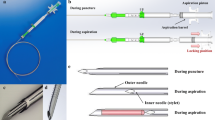Abstract
Background
Early detection of small pancreatic cancer is important because expected survival is markedly better for tumors ≤2 cm. A new endoscopic ultrasound-(EUS) guided biopsy needle with side fenestration has been recently developed to enable fine-needle biopsy (FNB) under EUS guidance. The aim of this study was to evaluate the outcome of EUS–FNB using a 22-gauge ProCore needle in solid pancreatic lesions ≤2 cm, in terms of diagnostic accuracy and yield.
Methods
From January 2011 to December 2012, all consecutive EUS-guided tissue sampling of small pancreatic lesions (≤2 cm) were performed using 22-gauge ProCore needles; the data of these patients were analyzed retrospectively.
Results
Sixty-eight patients with a mean age of 65.7 years were included. The mean lesion size was 16.5 mm (range 5–20). None of the patients developed complications. On pathological examination, the tissue retrieved was judged adequate in 58 out of 68 cases (85.3 %) and the presence of a tissue core was recorded in 36 out of 68 cases (52.9 %). The overall sensitivity, specificity, positive predictive value, negative predictive value, and accuracy were 80, 100, 100, 40, and 82 %, respectively.
Conclusion
Our results suggested that EUS–FNB of small pancreatic lesions using a 22-gauge ProCore needle is effective and safe, and supports our hypothesis that EUS–FNB is highly useful in establishing the nature of small pancreatic lesions.
Similar content being viewed by others
References
Schnelldorfer T, Ware AL, Sarr MG et al (2008) Long-term survival after pancreatoduodenectomy for pancreatic adenocarcinoma: is cure possible? Ann Surg 247:456–462
Cooperman AM (2001) Pancreatic cancer: the bigger picture. Surg Clin North Am 81:557–574
Cleary SP, Gryfe R, Guindi M et al (2004) Prognostic factors in resected pancreatic adenocarcinoma: analysis of actual 5-year survivors. J Am Coll Surg 198:722–731
Benassai G, Mastrorilli M, Quarto G et al (2000) Factors influencing survival after resection for ductal adenocarcinoma of the head of the pancreas. J Surg Oncol 73:212–218
Ahmad NA, Kochman ML, Lewis JD et al (2001) Endosonography is superior to angiography in the preoperative assessment of vascular involvement among patients with pancreatic carcinoma. J Clin Gastroenterol 32:54–58
DeWitt J, Devereaux B, Chriswell M et al (2004) Comparison of endoscopic ultrasonography and multidetector computed tomography for detecting and staging pancreatic cancer. Ann Intern Med 141:753–763
Sahai AV, Schembre D, Stevens PD et al (1999) A multicenter U.S. experience with EUS-guided fine-needle aspiration using the Olympus GF-UM30P echoendoscope: safety and effectiveness. Gastrointest Endosc 50:792–796
Ylagan LR, Edmundowicz S, Kasal K, Walsh D, Lu DW (2002) Endoscopic ultrasound-guided fine-needle aspiration cytology of pancreatic carcinoma: a 3-year experience and review of the literature. Cancer 96:362–369
Siddiqui AA, Brown LJ, Hong SK et al (2011) Relationship of pancreatic mass size and diagnostic yield of endoscopic ultrasound-guided fine needle aspiration. Dig Dis Sci 56:3370–3375
Iglesias-Garcia J, Poley JW, Larghi A et al (2011) Feasibility and yield of a new EUS histology needle: results from a multicenter, pooled, cohort study. Gastrointest Endosc 73:1189–1196
Larghi A, Iglesias-Garcia J, Poley JW et al (2013) Feasibility and yield of a novel 22-gauge histology EUS needle in patients with pancreatic masses: a multicenter prospective cohort study. Surg Endosc 27:3733–3738
Iwashita T, Nakai Y, Samarasena JB et al (2013) High single-pass diagnostic yield of a new 25-gauge core biopsy needle for EUS-guided FNA biopsy in solid pancreatic lesions. Gastrointest Endosc 77:909–915
Canto MI, Harinck F, Hruban RH et al (2013) International Cancer of Pancreas Screening (CAPS) Consortium. International Cancer of the Pancreas Screening (CAPS) Consortium summit on the management of patients with increased risk for familial pancreatic cancer. Gut 62:339–347
Chen J, Yang R, Lu Y et al (2012) Diagnostic accuracy of endoscopic ultrasound-guided fine-needle aspiration for solid pancreatic lesion: a systematic review. J Cancer Res Clin Oncol 138:1433–1441
Haba S, Yamao K, Bhatia V et al (2013) Diagnostic ability and factors affecting accuracy of endoscopic ultrasound-guided fine needle aspiration for pancreatic solid lesions: Japanese large single center experience. J Gastroenterol 48:973–981
Wiersema MJ, Vilmann P, Giovannini M et al (1997) Endosonography-guided fine-needle aspiration biopsy: diagnostic accuracy and complication assessment. Gastroenterology 112:1087–1095
Tadic M, Kujundzic M, Stoos-Veic T et al (2008) Role of repeated endoscopic ultrasound-guided fine needle aspiration in small solid pancreatic masses with previous indeterminate and negative cytological findings. Dig Dis 26:377–382
Katanuma A, Maguchi H, Yane K et al (2013) Factors predictive of adverse events associated with endoscopic ultrasound-guided fine needle aspiration of pancreatic solid lesions. Dig Dis Sci 58:2093–2099
Disclosures
Carlo Fabbri, Carmelo Luigiano, Antonella Maimone, Ilaria Tarantino, Paola Baccarini, Adele Fornelli, Rosa Liotta, Annamaria Polifemo, Luca Barresi, Mario Traina, Clara Virgilio and Vincenzo Cennamo have no financial arrangements or commercial associations (e.g., equity ownership or interest, consultancy, patent and licensing agreement, or institutional and corporate associations) which might be a conflict of interest in relation to the manuscript submitted.
Author information
Authors and Affiliations
Corresponding author
Rights and permissions
About this article
Cite this article
Fabbri, C., Luigiano, C., Maimone, A. et al. Endoscopic ultrasound-guided fine-needle biopsy of small solid pancreatic lesions using a 22-gauge needle with side fenestration. Surg Endosc 29, 1586–1590 (2015). https://doi.org/10.1007/s00464-014-3846-6
Received:
Accepted:
Published:
Issue Date:
DOI: https://doi.org/10.1007/s00464-014-3846-6




